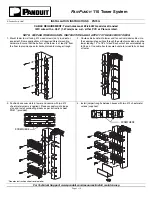
LanScaper
TM
3.2.4 Tone Generator
3.3 Network Test Modes
3.3.1 Flash Link LED
3.3.2 PING Test
DHCP On Mode
- The tone mode generates audio tones for use with tone tracers on all pairs,
a selected pair or a selected pin. The signal generated on a pair has the signal on one pin and the
complement of the signal on the other pin of the pair, yielding a nominal 10 volts peak-to-peak
across the pair. The SEL button selects one of the four tone sounds provided. The up/down arrows
scroll through the pairs and pins that have signal on them. All pins not being driven are held at
tester ground. The LanScaper™ will automatically turn off in 60 minutes.
- The Flash Link LED mode starts with the Voltage Check test (see section
above) then searches for link pulses on the tester's jack, automatically configuring the interface to
connect to a HUB, switch or NIC (similar to AUTO MDI/MDI-X) if one is found. An audio tone
signal is being sent down the cable, so the cable can be located at the other end with a tone tracer
whenever this mode is selected. The tone cadence is different for an open cable versus an
established link to indicate the link status. Once a link is established, the Link LED on the
LanScaper™ will illuminate and begin blinking at the same rate as the link indicator on the device
at the other end. The LanScaper™ will automatically turn off in 30 minutes.
While the tester is searching for incoming link pulses, it displays the message “Find Active Link.”
Once link pulses are found, the tester displays “Link Found” and the Link LED flashes. If the tester
detects that the incoming link pulses stop, it reports “Lost Link” for several seconds, then returns to
the search for link pulses.
- The PING Test operates in DHCP On or DHCP Off (Manual) IP address
configuration modes. The address configuration mode is a setup option. In either case, a Target
device must be selected in Setup, and its IP address confirmed. If the Target address is on the LAN
segment, as determined by the Netmask, the Target will be addressed directly on the Ethernet. If
the Target is not local, PINGs will be directed to the Router for forwarding on the WAN side of the
Router. When running in this mode, the LanScaper™ will respond to PINGs addressed to it from
any other device.
In this test, the LanScaper™ checks for voltages, then searches for link pulses on it's jack,
automatically configuring the interface to connect to a HUB, switch or NIC. Once an active link is
found, the tester configures its IP address parameters as selected by the user. Once the parameters
are set, the tester starts sending out PING packets to the selected Target, the Router, and (in DHCP
mode) the DNS server. The PINGs continue for 15 minutes after the last button press, after which
the LanScaper™ will automatically turn off.
- After detecting incoming link pulses, the tester requests IP address parameters
using the DHCP protocol. The tester displays the message “DHCP Request” and a count of
attempts. This protocol requires a response from a DHCP server accessible on the LAN. If no
response to its request is received after 10 seconds, the tester will repeat its request, and increment
the count on the screen. Once the tester gets a response from a server, it displays the message
“Successful”. No manual configuration is required for the DHCP protocol to work. If the tester
continues to count requests, the most likely problem is that a DHCP server is not available on the
LAN. In that case, the tester must be manually configured. For information on that mode, see the
DHCP Off section below.
Once the DHCP server has provided the LanScaper™ with a value for the address the tester will
use (MyIP), that address is checked for conflict. The tester issues an Address Resolution Protocol
Summary of Contents for LanScaper NT700
Page 1: ...LanScaper TM OPERATING INSTRUCTIONS...
Page 4: ......





























